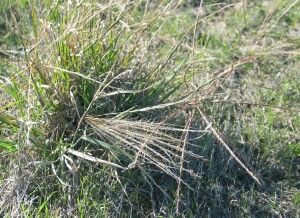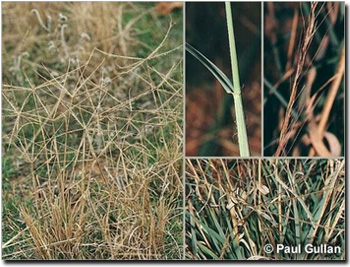Curly Windmill-grass
Back | Salinity Indicator Plants Home | Common name home | Scientific name home | Photo Gallery | Glossary
| Curly Windmill-grass photos | Family: Grass (Poaceae syn. Gramineae) |
| Scientific Name: | Enteropogon acicularis | ||||||
Other Common Name: | Large Windmill Grass, Spider Grass | ||||||
| Status: | Native to all mainland States of Australia. | ||||||
Plant Description: | Tussocky, perennial grass, to 50 cm high and 30 cm diameter, with bluish-green, rough, flat leaves (up to 20 cm long and 6 mm wide), that are hairless or with occasional hairs, and characteristically curling when dry. Windmill-like flower-head consisting of 7 – 15 spikes, stiffly spreading from the tip of the stalk in several different planes, the spikes 5 – 18 cm long. Each spikelet has 2 – 3 narrow-lanceolate (spear-like), awned florets, the lower with an awn 9 – 15 mm long. Spikelets usually turn purplish at maturity. Flowering mainly spring – autumn. | ||||||
|
| ||||||
Comments: | There are several grasses with similar windmill-like flower-heads. Curly Windmill-grass and Windmill-grass tend to occur as individual tufted plants and have large flower-heads with many spikes and have awned florets, whereas Couch Grass (Cynodon dactylon) spreads along and through the ground by stolons and rhizomes (often forming mats), has up to 6 spikes only and its florets are awnless. Windmill-grass (Chloris truncata), unlike Curly Windmill-grass, has truncate (or flat-topped) florets. | ||||||
 Curly Windmill-grass tussock and maturing flower-heads Photo: A J Brown |  Curly Windmill-grass spikelets clustered along spikes Photo: A J Brown | |
 Curly Windmill-grass digitate (finger-like) spikes Photo: A J Brown |  Curly Windmill-grass tussock and fresh flower-head Photo: A J Brown |



